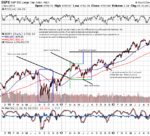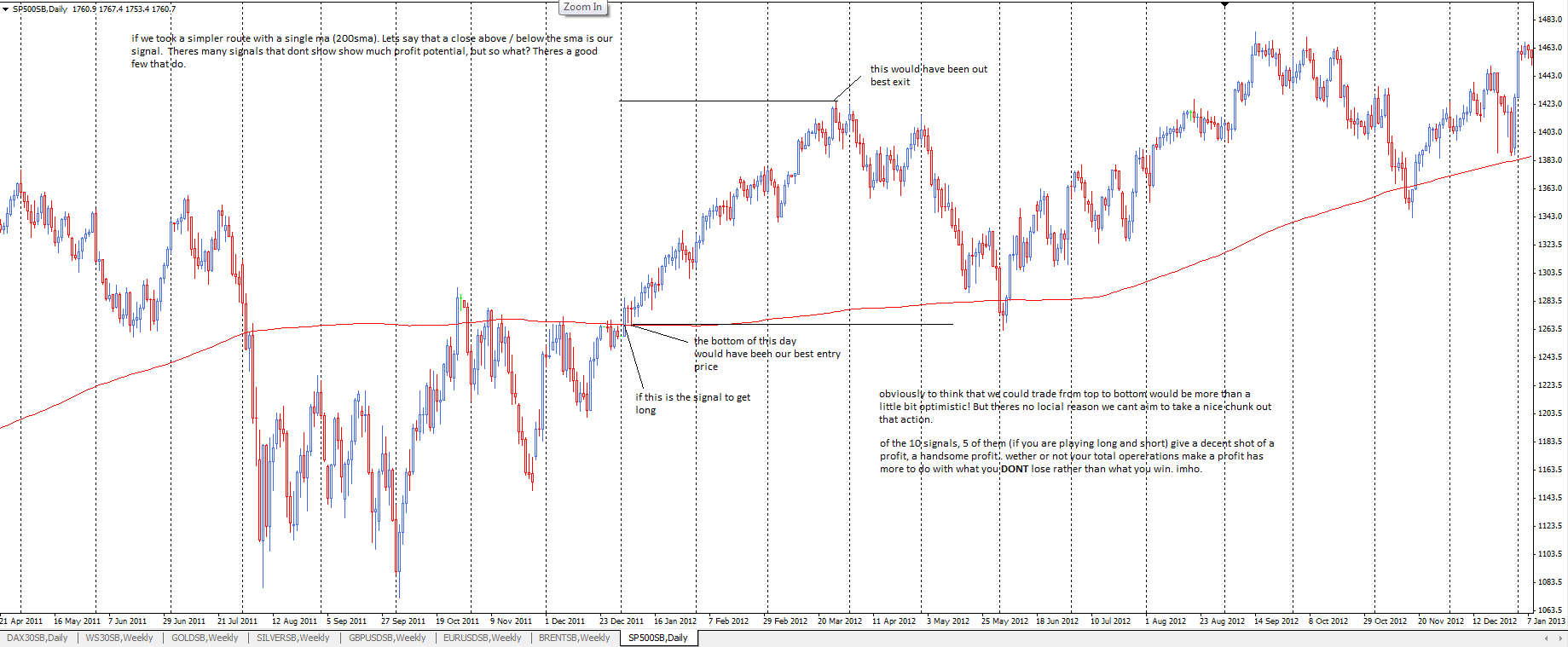This is going to be a long post, it relates to the efficacy of Moving Averages, (MA's).
I have been fascinated with MA's for about a year, and have most likely spent more than a couple hundred hours investigating them.
It's so easy to find systems based on MA's, whether it be simple, double, triple or C.O.M.A (correct order moving average), systems..
There are literally hundred of videos on youtube.com, showing great examples of how to become the next Buffet using some basic MA.
But do they really work:?: - and by work I mean significantly beat the growth of an index, like SP500, NASDAQ or Russel2000.
Let's see...
I found this thread
http://www.trade2win.com/boards/trading-software/152456-moving-average-crossover-backtester.html
and deiced to test different MA's that I have found to deliver significant results on http://www.zignals.com/, and http://www.tradingblox.com/.
I selected 52 complelty randomly chosen tickers, and tested their performance, going back 5 years, using the movingaveragebacktester.com site.

I have colored all total return cells, for the 5 year period that are under 100% green, because that would equate to less than 20% annually. Which is a joke.
The conclusion for each of the 10 different moving average combinations is as follows.
http://i.cubeupload.com/KhuoO3.png
So, using these moving averages, purely from a technical perspective, we can see that 65 short combined with a 115 long delivered the best results over a 5 year period - 21% YOY.
But how does that compare to just buying an index.
SP500 delivered 17.84% per annum
NASDAQ delivered 27.61% per annum
Because there are more risks with individual stocks, we diversify and this increases our trading fees, so with trading fees I would argue that it just buying the index would have been an easier and better bet.


These are not the only moving averages I have tested, other tested included, smoothed, weighted, delayed (TSF), etc. moving averages.
If we compare the best yielding MA 65/90 to buy and hold on the First Trust NASDAQ-100 Equal Weight Idx (QQEW), we again see that buy and hold outperformed.
139% versus 108%, over the 5 years.
This really makes me wonder, how do you trade using MA's?
Does it mean using FA and TA in combination, but is difficult because you have to wait for crossovers, or just use a single MA to serve as a trend line, which also means that MA's just become a confirmation and mayhap stop loss tool.
Or does it mean that MA's can work, but tend to work best on less volatile stocks and longer MA's?
I came accross research on SMATrader.com, which indicated that longer double cross SMA's can significally outperform the market.
His test was conducted over 15 years data on the DAX and SP500.
 [/IMG],
[/IMG],
It's pretty clear from his work that, there are MA's that deliver good results (twice the growth over 15 years), with two clear triangles being visible. 100 for the short SMA and between 200 to 300 on the long SMA seems to deliver very good results.
My problem with that is waiting 3 years for a trade signal.
I have been fascinated with MA's for about a year, and have most likely spent more than a couple hundred hours investigating them.
It's so easy to find systems based on MA's, whether it be simple, double, triple or C.O.M.A (correct order moving average), systems..
There are literally hundred of videos on youtube.com, showing great examples of how to become the next Buffet using some basic MA.
But do they really work:?: - and by work I mean significantly beat the growth of an index, like SP500, NASDAQ or Russel2000.
Let's see...
I found this thread
http://www.trade2win.com/boards/trading-software/152456-moving-average-crossover-backtester.html
and deiced to test different MA's that I have found to deliver significant results on http://www.zignals.com/, and http://www.tradingblox.com/.
I selected 52 complelty randomly chosen tickers, and tested their performance, going back 5 years, using the movingaveragebacktester.com site.

I have colored all total return cells, for the 5 year period that are under 100% green, because that would equate to less than 20% annually. Which is a joke.
The conclusion for each of the 10 different moving average combinations is as follows.
http://i.cubeupload.com/KhuoO3.png
So, using these moving averages, purely from a technical perspective, we can see that 65 short combined with a 115 long delivered the best results over a 5 year period - 21% YOY.
But how does that compare to just buying an index.
SP500 delivered 17.84% per annum
NASDAQ delivered 27.61% per annum
Because there are more risks with individual stocks, we diversify and this increases our trading fees, so with trading fees I would argue that it just buying the index would have been an easier and better bet.


These are not the only moving averages I have tested, other tested included, smoothed, weighted, delayed (TSF), etc. moving averages.
If we compare the best yielding MA 65/90 to buy and hold on the First Trust NASDAQ-100 Equal Weight Idx (QQEW), we again see that buy and hold outperformed.
139% versus 108%, over the 5 years.
This really makes me wonder, how do you trade using MA's?
Does it mean using FA and TA in combination, but is difficult because you have to wait for crossovers, or just use a single MA to serve as a trend line, which also means that MA's just become a confirmation and mayhap stop loss tool.
Or does it mean that MA's can work, but tend to work best on less volatile stocks and longer MA's?
I came accross research on SMATrader.com, which indicated that longer double cross SMA's can significally outperform the market.
His test was conducted over 15 years data on the DAX and SP500.

It's pretty clear from his work that, there are MA's that deliver good results (twice the growth over 15 years), with two clear triangles being visible. 100 for the short SMA and between 200 to 300 on the long SMA seems to deliver very good results.
My problem with that is waiting 3 years for a trade signal.
Last edited:






